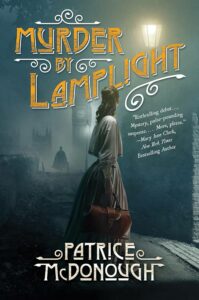Debut
 If I were a magic eight ball, I’d say that all signs point to this satisfying and enjoyable debut setting up a series with a long, long run. Set in London in 1866, the central character is Dr. Julia Lewis, an American educated physician (it was not possible for women to get a degree in England at the time) who is running her grandfather’s practice. But because he is ill, when the office gets the order to attend to a murder victim, it’s Julia who must take the call.
If I were a magic eight ball, I’d say that all signs point to this satisfying and enjoyable debut setting up a series with a long, long run. Set in London in 1866, the central character is Dr. Julia Lewis, an American educated physician (it was not possible for women to get a degree in England at the time) who is running her grandfather’s practice. But because he is ill, when the office gets the order to attend to a murder victim, it’s Julia who must take the call.
The dead man is a priest, found mutilated and naked, and though the police on the scene are initially a bit shocked at Julia’s gender, they eventually accept her expertise. Inspector Tennant is controlled and quiet, and he and the doctor begin awkwardly, but gradually smooth things out.
The priest is the first in a string of deaths that are certainly related – sharing certain features as well as a specific clue left with each body – but exactly how is the question. They could be tied to the workhouse, or a cholera outbreak, or perhaps even to a “Molly” house, a place for gay men.
One of the many reasons why this is such a great set up for a series is its time period. It was highly unusual for a woman to be a doctor at the time, so Julia’s status and the way she fights for her place in the world reveal her feisty, fearless and practical character. Mirroring Julia is well born Inspector Tennant, who, after an army discharge, has had to find a place with the police, and then only through the patronage of a well-placed godfather. He’s uncomfortable with his status and can sympathize with Julia’s frustrations as he struggles to establish himself in his own way.
A second reason is the way McDonough delineates different parts of Victorian London (it sounds very un-delicious), as she looks at workhouses, cholera and the general status of children who have been abandoned or orphaned, forced to make some kind of living on the streets. Because McDonough relates the conditions and illuminates the lives of the characters who are living through these dire situations in a very straightforward and matter of fact manner, their stories resonate.
A third reason is that she’s created not just two very solid central characters in Julia and Tennant, but also a memorable family for Julia (her grandfather and a nosy aunt), a colorful and intelligent Irish cop who works with Tennant, and a boy that Julia takes in to work at her clinic, all who seem poised to become series regulars.
The final reason is that this is quite a fine mystery, all on its own. The serial killer story can be a bit overdone, but McDonough’s made it less thriller than whodunnit (though there is a thrilling scene toward the end), and the clues are uncovered by the solid police work of Tennant’s crew as well as intelligent deductions on Julia’s part. Because the author has also made the reader actually care about these characters, the resolution gains emotional resonance and you find yourself rooting for Julia and whatever her relationship with Tennant will bring. This is simply the best series kick-off I’ve read since Victoria Thompson’s Murder on Astor Place. — Robin Agnew